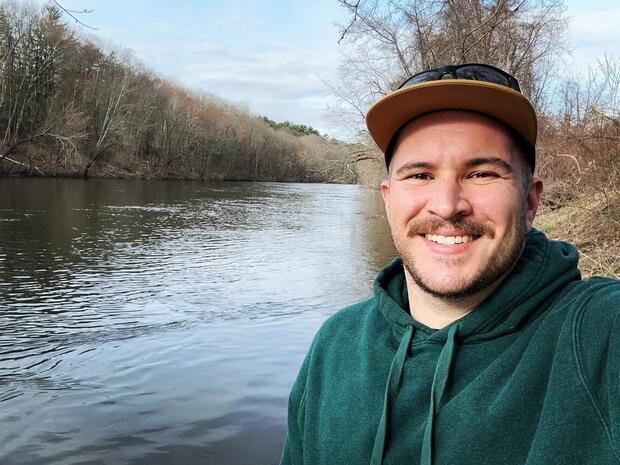Letter from the Director
Dear Friends and Colleagues,
With all of the recent heat, summer feels like it is in full swing, but what better way to start off this season than by looking back on the amazing spring we had? For DER, spring marked the beginning of construction for several Priority Projects, such as the South Meadow Wetland Reserve Easement Restoration in Carver and the Whitney Pond Dam Removal in Ashburnham. It was also a season for planning and preparation for our restoration projects. In this issue of the Ebb & Flow, you’ll get an update on construction at the Herring River Estuary Restoration Project in Wellfleet and Truro, the benefits of wetland restoration, the exciting afternoon DER spent with Governor Healey at a culvert in Becket, DER’s new staff, and more.
With the Governor’s announcement of the Mass Ready Act earlier this week, we are excited to see such a historic investment in our environment, including important investments in ecological restoration, biodiversity conservation, and public access to nature for all. Investing in our future through ecological restoration projects, especially as we continue to feel the impacts of climate change, is crucial for both our communities and ecosystems. DER looks forward to continuing to drive this work forward and collaborating with our partners this summer.
I’ll see you on the river,
Beth Lambert, Director
Construction Check-In
Warmer temperatures and thawing ground mean that DER had a few new projects break ground this spring. Currently, DER has five projects under construction. Here’s a look at what’s underway:
South Meadow Wetland Reserve Easement Restoration, Carver: This Priority Project began construction in May on 34 acres of retired commercial cranberry farmland. After nearly 100 years of farming on the property, the landowner retired the bogs in November 2021 and pursued a restoration pathway with the USDA Natural Resources Conservation Service (NRCS) and DER. This spring, the project owner is preparing the site by mobilizing machinery and setting up the erosion and water control. Project partners include DER, the landowner, NRCS, and Beals and Thomas.
Ware River Restoration/Wheelwright Dam Removal, Hardwick and New Braintree: After many years of planning, this project entered its first construction phase by beginning a multi-year impoundment drawdown. To minimize potential impacts to sensitive species, the project team is removing stop log timbers from the dam’s floodgates and beginning water management. This project will improve public safety by removing an aging dam, reconnecting over 100 miles of mainstem and tributary habitat, and increasing recreational opportunities when complete. Project partners include DER, the East Quabbin Land Trust, and the private dam owner.
Whitney Pond Dam Removal, Ashburnham: Another one of DER’s Priority projects that began construction this spring, this project is removing a Significant hazard dam in poor condition, and restoring river connectivity in the Whitman River, a designated coldwater fishery. Site preparation and mobilization began in May, and the first of three phases of dam demolition is starting in June. Project partners include DER, the Town of Ashburnham, and the Nashua River Watershed Association which is one of the core partners of the Merrimack Restoration Partnership.
Upper Coonamessett River Restoration, Falmouth: Construction is underway to restore 20 acres of former cranberry bogs into healthy wetlands along the upper Coonamessett River. Over the winter, crews were busy removing existing culverts, reconstructing the river channel, and conducting sand removal and roughening on the bog surface. This spring, recreational improvements such as path grading and boardwalk construction are underway, along with final grading and plantings within the bogs themselves. This project seeks to improve stream health, enhance fish passage, and provide recreational opportunities along the upper portion of the Coonamesset River Watershed. Project partners include DER, Town of Falmouth, Coonamessett River Trust, USFWS, NOAA Restoration Center, Mass Audubon, and many others.
In addition to these, construction on the Herring River Estuary Restoration in Wellfleet and Truro is still underway. Read more about that project below and check out previous issues of DER’s Ebb & Flow to read about two DER projects that wrapped up over the winter.
Staff Welcome
New faces joined DER’s Stream Continuity Program this spring! DER is excited to welcome Eli Velluti-Fry and Natalia Ruiz to our team.
Eli Velluti-Fry: Eli joins DER’s Stream Continuity Program as a Culvert Replacement Technical Assistance Specialist. Originally from Ohio, Eli brings grant management experience to his new role. Most recently, he was the MassTrails Grants Program Manager with the Department of Conservation and Recreation where he helped fund and support trail projects statewide. Along with managing the grants, he also provided technical assistance to non-profits and municipalities, something he will continue to do in this new position.
Natalia Ruiz: Natalia also joins DER’s Stream Continuity Program as a Culvert Replacement Technical Assistance Specialist. With a background in Natural Resources Conservation focusing on wetland studies, Natalia recently completed their M.S. in Geography. Natalia also brings knowledge and experience in freshwater ecology and GIS hydrologic modeling to their new role, where they will be working closely with partners and communities to help drive stream crossing replacement projects forward.
DER Shares Culvert Replacements with Governor Healey
In mid-March, DER spent the afternoon in Lenox and Becket with Governor Healey, Executive Office of Energy and Environmental Affairs Secretary Rebecca Tepper, Department of Fish and Game Commissioner Tom O’Shea, Department of Transportation Secretary Monica Tibbits-Nutt, and many others to highlight proposed funding improvements for roads, bridges, and culverts across Massachusetts.
The Governor’s transportation plan proposes using Fair Share revenue to upgrade culverts and small bridges throughout the state, with a specific focus on smaller and rural communities. With about 25,000 culverts in Massachusetts, the majority of which are undersized and/or deteriorating, culvert replacement is essential. In addition to protecting communities from storms and improving public safety, upgrading undersized and aging culverts and bridges also restores river connectivity, improves fish and wildlife passage, boosts biodiversity, and much more.
The day began with a town hall discussion, then in the afternoon, DER, Governor Healey, and others swapped their public meeting shoes for boots and safety vests to visit a successful culvert replacement project in Becket. This previously-undersized culvert on Bonny Rigg Hill Road had failed three times in six years during severe storms, washing out the road and threatening public safety. In 2017, the culvert was replaced with a larger, safer structure, which served as a training site for state and municipal leaders to learn about culvert replacement. DER had the opportunity to get up close to the new structure and discuss this site with Governor Healey as an example of the work that can be done through state investment and the benefits it can bring.
Learn more about this exciting news in the press release.
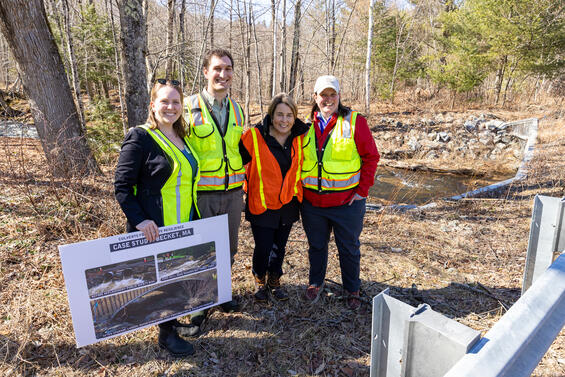
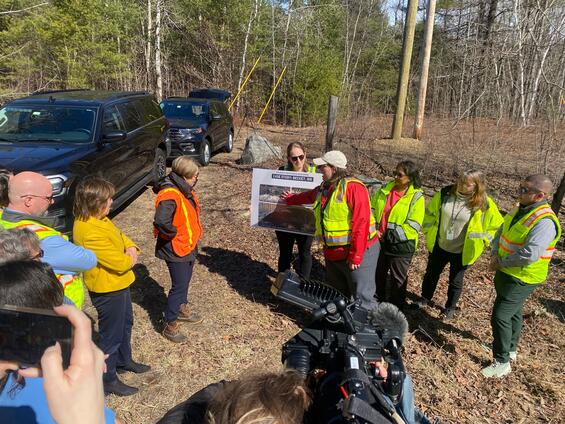
Construction Milestones Reached at Herring River
The Herring River Estuary Restoration Project hit exciting construction milestones this spring! The largest tidal estuary restoration ever undertaken in Massachusetts and the northeastern United States, this project will restore up to 890 acres of degraded salt marsh and estuarine habitats. After many years of preparation, the project team started construction on this project in 2023, with work focusing on several components including replacing the tidally restrictive dike at the mouth of Herring River with a bridge that will allow the tide to flow between the river and Wellfleet Harbor. To maintain traffic and pedestrian access, crews built a temporary bridge near the end of 2023, allowing work on the dike to move forward.
Crews are now building a permanent bridge to replace the dike in two stages. The first stage was the construction of the southern portion of the bridge, which includes five tidal gates, set to mimic the existing tidal flow conditions of the diked system. Continuous tidal monitoring equipment has been installed upstream and downstream of the dike to ensure these conditions are met. In March, a few DER staff members and project partners witnessed the tide flow through the newly installed tidal gates in the southern section of the permanent bridge for the first time since the river was diked in 1909.
Constructing and opening the new gates is intentionally gradual, following a carefully designed protocol. Initial gate settings will maintain pre-construction water levels until the bridge construction and integrated project elements are complete. Once specific project milestones are met, crews will gradually open the gates under the guidance of a monitoring program to initiate tidal restoration. Progressing slowly also allows for a smoother transition from the restricted tidal flushing caused by the existing undersized culverts to more natural conditions that closely resemble the Herring River’s historic flow before the dike.
Transition of flow to the southern bay of the Chequessett Neck Road Bridge allowed for construction to begin on the northern portion of the bridge. During this stage of construction, the contractor unearthed and demolished the existing three-bay culvert that had been the dike’s sole water control structure dating back to the 1970s. With the tidal flow transitioned to the south and the old culvert removed, the contractor is now focusing their effort on the construction of the central and northern spans of the bridge. When completed, the permanent bridge will span roughly 195 feet and incorporate seventeen tide gates across three sections.
To see the progress firsthand, Friends of Herring River created a timelapse video of the construction from April 2024 to March 2025. The Chequesset Neck Bridge construction is just one of the many components of this landmark project. Be sure to follow along as we share more upcoming milestones. Partners on this project include the Town of Wellfleet, National Park Service, Natural Resources Conservation Service, NOAA, US Fish and Wildlife Service, National Fish and Wildlife Foundation, Friends of Herring River, and many others.
May was American Wetlands Month
Each May, American Wetlands Month is a chance to recognize and celebrate the important role that wetlands play in our environment. Massachusetts is home to over 48,000 acres of diverse wetlands from coastal marshes to inland bogs, vernal pools, and more. As nature’s multitaskers, wetlands provide countless benefits to our ecosystems and communities. They filter pollutants from water, store carbon, offer recreation opportunities, and create habitat for a wide variety of species. Wetlands also play a crucial role in preventing flooding and protecting against coastal storms, especially as climate change increases the frequency and severity of these events.
Unfortunately, many wetlands have been filled, drained, ditched, polluted, and otherwise damaged over the centuries due to agriculture and industrial development. To undo the damage, DER works with partners across the Commonwealth to implement wetland restoration projects. These projects often focus on reestablishing natural hydrology, reconnecting rivers to their floodplains, removing obsolete dams and/or culverts, and restoring native vegetation.
In Bourne, for example, the Wing’s Neck Salt Marsh Restoration involved replacing a severely undersized culvert that had restricted tidal flow to Pocasset Harbor. This restriction degraded eight acres of upstream salt marsh and prevented drainage after large storms. In the summer of 2002, two box culverts were installed to restore tidal exchange, decrease flooding during storms, and restore habitat for birds, fish, and vegetation.
Heading inland for an example of an active wetland restoration project, DER is currently working with the City of Northampton and Mass Audubon to restore Nashawannuck Brook and the historical freshwater wetlands that once existed on the former Pine Grove golf course. Currently in design and permitting, this project will increase stream and floodplain connectivity, improve wildlife habitat, enhance carbon sequestration, and provide recreational opportunities on a parcel that connects it to other protected lands in Northampton.
Restoring wetlands not only strengthens our communities and water infrastructure but also supports healthy, resilient ecosystems. Whether you are kayaking, hiking, or simply driving by, wetlands are a great place to get outside and see the resilience of nature firsthand. Head to our project map on our website to find a wetland restoration project near you.

Project Highlight: Monatiquot/Fore River Restoration
For the first time in over 200 years, Braintree residents witnessed river herring swimming through the Monatiquot River as part of their annual migration in early May. Two years prior, their travels would have been halted by two large defunct dams along the river, keeping them from crucial spawning habitat upstream. DER selected the Monatiquot River Restoration in Braintree as a Priority Project in 2017. After years of planning, the Town of Braintree removed the two dams, restored the river channel, and constructed a fishway at the scenic Rock Falls just downstream.
The Armstrong Dam was a 12-foot-high, 92-foot-long concrete structure, and the smaller Ames Pond Dam was just downstream. Historically, these structures were part of a mill, but 200 years later, were aging and deteriorating, increasing the risk of upstream flooding and raising concerns about future dam failures during major storms. The dams had also made fish and wildlife passage impossible for species like river herring, American eel, turtles, and many more. In 2023, the project team demolished both dams, removed 6,800 cubic yards of contaminated sediment, and restored the river channel. Now finishing the final phase this spring, a boardwalk and viewing platform are being built to provide long-awaited public access to the river.
By removing the two aging barriers, this project opened 36 river miles, strengthened community resilience, improved water quality, restored natural river processes, and revolutionized a vital part of Braintree. Located right in the heart of the community, the project showcases the dedication of many federal, state, and nonprofit partners, years of coordination, and strong community support. Partners on this project include the Division of Ecological Restoration, Division of Marine Fisheries, Town of Braintree, Fore River Watershed Association, NOAA Restoration Center, Municipal Vulnerability Preparedness Program, Dam and Seawall Repair or Removal Program, US Fish & Wildlife Service, and a private dam owner.
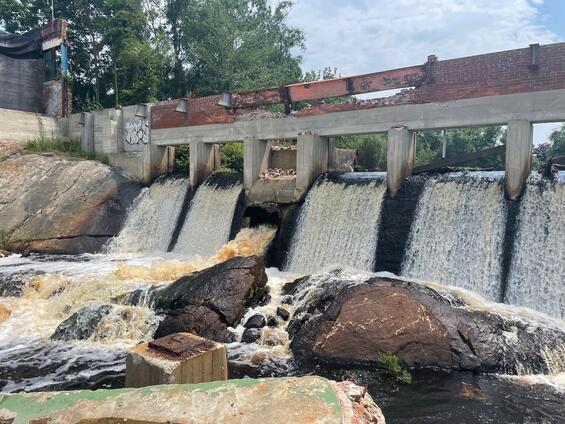
The Armstrong Dam, which was removed as part of the Monatiquot River Restoration Project, prior to removal. (Credit: DER)
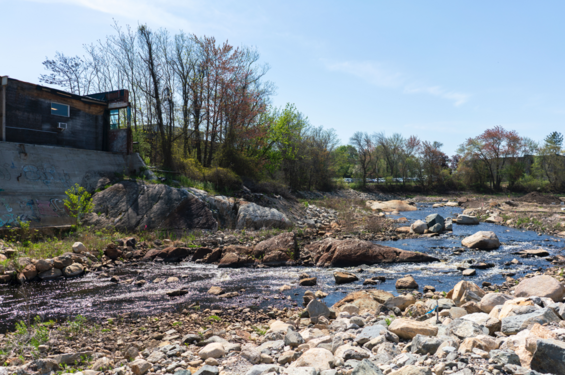
The Monatiquot River flows through where the Armstrong Dam once stood. (Credit: Julia Hopkins, DFG)
